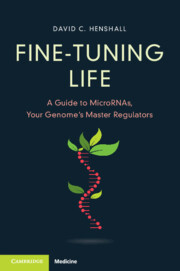Book contents
- Fine-Tuning Life
- Reviews
- Fine-Tuning Life
- Copyright page
- Dedication
- Contents
- Figures
- Ode to the MicroRNA
- Acknowledgements
- Common Terms and Definitions
- Introduction
- Chapter 1 Discovered!
- Chapter 2 MicroRNAs Emerge as Master Controllers
- Chapter 3 Epic Journey
- Chapter 4 Opening Act
- Chapter 5 MicroRNAs Shape the Machinery of Our Minds
- Chapter 6 Centre of the Electrical Storm
- Chapter 7 MicroRNAs Become Medicines
- Chapter 8 Circulating MicroRNAs Provide a Diagnosis
- Chapter 9 Finale and Encore for MicroRNAs
- References
- Index
Chapter 6 - Centre of the Electrical Storm
MicroRNAs and Epilepsy
Published online by Cambridge University Press: 14 June 2024
- Fine-Tuning Life
- Reviews
- Fine-Tuning Life
- Copyright page
- Dedication
- Contents
- Figures
- Ode to the MicroRNA
- Acknowledgements
- Common Terms and Definitions
- Introduction
- Chapter 1 Discovered!
- Chapter 2 MicroRNAs Emerge as Master Controllers
- Chapter 3 Epic Journey
- Chapter 4 Opening Act
- Chapter 5 MicroRNAs Shape the Machinery of Our Minds
- Chapter 6 Centre of the Electrical Storm
- Chapter 7 MicroRNAs Become Medicines
- Chapter 8 Circulating MicroRNAs Provide a Diagnosis
- Chapter 9 Finale and Encore for MicroRNAs
- References
- Index
Summary
Epilepsy is one of the most common neurological disorders, affecting people of all ages. This chapter focusses on what has been learnt about the microRNA system in this important disease. Starting with an overview of epilepsy, it addresses what causes seizures to occur and some of the underlying mechanisms, including gene mutations and brain injuries. It explores how and which microRNAs drive complex gene changes that underpin but also oppose the enduring hyperexcitability of the epileptic brain. This includes by regulating amounts of neurotransmitter receptors, structural components of synapses, metabolic processes and inflammation. It also covers some of the earliest studies linking microRNAs to epilepsy as well as recent large-scale efforts to map every microRNA and its target in the epileptic brain. Finally, it highlights ways to model epilepsies and use of experimental tools such as antisense oligonucleotides to understand the contributions of individual microRNAs. Collectively, these studies reveal how microRNAs contribute to the molecular landscape that underlies this disease and offer the exciting possibility of targeting microRNAs to treat genetic and acquired epilepsies.
Keywords
- Type
- Chapter
- Information
- Fine-Tuning LifeA Guide to MicroRNAs, Your Genome's Master Regulators, pp. 140 - 174Publisher: Cambridge University PressPrint publication year: 2024

